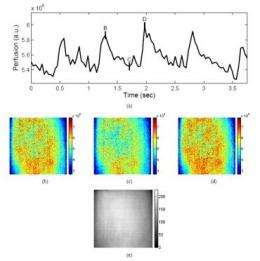A continuous recording of the blood circulation of the hand of a healthy test person; the graph (above) shows the average blood circulation, and b through d show the entire situation for the period of time on the graph: the heart beat can be observed.
(PhysOrg.com) -- Burns or other disorders that disrupt the blood flow in tissues will soon be easier to assess thanks to a camera that is capable of imaging blood circulation in real time. Compared to an earlier version, the new optical perfusion camera (TOPCam) from Twente, the Netherlands, is a significant improvement with regard to speed, so that even small variations in blood circulation are immediately visible.
The camera is now ready for clinical application. Researchers of the Institute for Biomedical Technology (BMTI) are publishing an article on the camera in the March number of Optics Express.
After earlier successful tests at the Martini Hospital in Groningen, the Netherlands, the researchers have made a number of significant improvements to the camera. The speed of the earlier version was commended by doctors and nurses, but real-time images of variations in the blood circulation were not yet possible. They are now, though, according to researcher Wiendelt Steenbergen: “We can now see rapid variations in blood circulation, too, for example when the circulation gets going again after occlusion of an arm or after a transplant.” The measured reaction gives an immediate impression of the condition of the vascular bed.
A continuous recording of the blood circulation of the hand of a healthy test person.
The researchers were able to reach these high speeds by using a broad laser beam to simultaneously illuminate the entire area of skin in question. Images are made of the tissue with a high-speed camera. Laser light that is scattered by moving red blood cells gives variation in the clarity of the pixels as a result of the Doppler Effect. Up till now it had been a problem transferring all the data to the computer quickly enough, but real time images are now enabled by making better use of the camera memory.
Now that the newest modifications have been made, the camera is ready for clinical application, Steenbergen says. The TOPCam is also suitable for other applications such as the assessment of blood circulation in diabetics.
More information: The article Twente Optical Perfusion Camera: system overview and performance for video rate laser Doppler perfusion imaging by Matthijs Draijer, Erwin Hondebrink, Ton van Leeuwen and Wiendelt Steenbergen is appearing in the March number of Optics Express.
Provided by Universiteit Twente





















